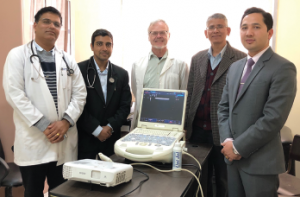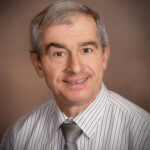
Physicians stand behind the ultrasound Dr. Paul Halverson brought to Patan Hospital, Nepal, for the new rheumatology training program. From left: Drs. Keshav Raj Sigdel, Ujjwal Risal, Paul Halverson, Buddhi Paudyal and Jiwan Poudel.
patrice6000 / shutterstock.com
A Milwaukee rheumatologist delivered lectures, participated in Grand Rounds and consulted on rheumatology treatment strategies during his visit this winter to the Patan Academy of Health Sciences (PAHS), Nepal.
Paul Halverson, MD, affiliated with Froedtert Hospital and the Medical College of Wisconsin, says the several days he spent in Patan, Nepal, adjacent to Kathmandu and the Himalayan foothills, “were great. [The people] were very hospitable and so appreciative of anything that anyone can offer to help them with.”
The mission of PAHS and its teaching hospital, Patan Hospital, is to provide sustained improvement of the health of people in Nepal, particularly people who are poor and living in rural areas. In addition to providing care through its hospitals and clinics, PAHS collaborates with the national health system to improve the health of the people of Nepal and to encourage development of appropriate health policies, programs and systems that will aid the rural poor. PAHS also helps students from underprivileged sectors of the country access health science education.
Patan Hospital, a public hospital and major teaching hospital for PAHS, started an internal medicine residency program in 2017. Its mission is to provide quality and compassionate care to everyone who comes, regardless of their ability to pay. The first public clinic in rheumatology in Nepal was opened October 2018 by Buddhi Paudyal, MD, a professor of medicine at PAHS. Dr. Paudyal was born in Nepal, had an early desire to study medicine, attended medical school and then served a medical residency in Nepal. He was also an Ogryzlo Fellow at the University of Toronto.
A major purpose of Dr. Halverson’s trip was to transport a donated ultrasound machine to Dr. Paudyal’s new rheumatology training program at Patan Hospital. “My fears about bringing the equipment into the country were unfounded; I was waved through customs,” he says.
Dr. Halverson’s journey had begun in Thailand a week before, where he was attending the Christian Dental Medical Association conference. “I happen to go to Thailand every couple of years, and that is not very far from Nepal. I just hopped on over there for about six days.”
Nepal is one of the most impoverished countries in the world, but doctors at the clinic have access to many therapies used in Western rheumatology treatment, except for biologic therapies, Dr. Halverson says. “I was impressed that doctors do have potential access to a lot of modern medical care, although it may require getting meds from India or actually going there.
“No visas are required to go back and forth across the border between India and Nepal. I was led to believe that, on some occasions, someone may go to India to get biologic therapies. However, that is the exception and not the rule, because people just do not have the funds to pay for these drugs, and there is no insurance. So even though obtaining the drugs is a possibility, it is improbable that people will have the money to pay for them.”
Doctors at the clinic “are very aware of Western treatment, and their program and treatment are modeled on Western style medicine,” he says. “Even though physicians talk about how traditional treatments, such as Ayurvedic medicine, continues to draw some patients, people willing to use Western medicine have the usual choices for rheumatologic therapy, such as methotrexate, mycophenolate, sulfasalzine, etc,” he says. “They do have the typical things available, up to about the year 2000 when biologics became available.”

